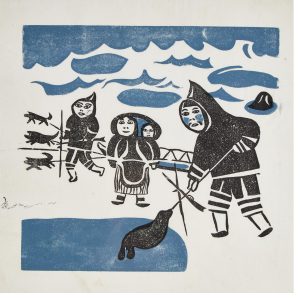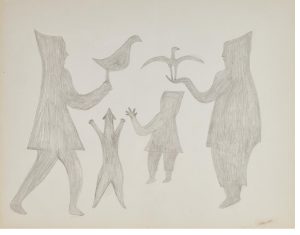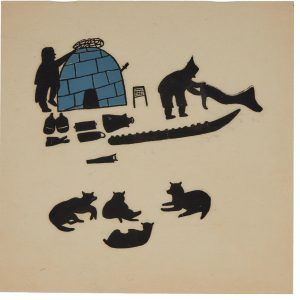
For almost 50 years Terry Ryan was the art advisor and general manager of the West Baffin Co-operative (WBEC) in Kinngait (Cape Dorset). Much like his predecessor and fellow Ontario College of Art graduate James Houston, Ryan had a passion for the Arctic and its people, with whom he lived for the better part of his life. Speaking of Ryan in his 2017 obituary in The Globe and Mail, John Westren of Dorset Fine Arts said of Ryan that he dedicated himself to the task of supporting the co-op: “it was his whole life. He was one of those old-fashioned men of integrity.”
Ryan was passionate about art, and worked closely with nearly all of the early, now-celebrated Kinngait artists. Selections from the Terry Ryan collection were offered by Waddington’s in 2019 and again in 2020. We are pleased to be able to offer an additional installment of 33 rare drawings and prints from his collection, by artists including Niviaxie, Sheouak Petaulassie, Napachie Pootoogook, Kenojuak Ashevak, Kingmeata Etidlooie, Anirnik Oshuitoq, Henry Evaluardjuk, Mary Pitseolak, Eleeshushe Parr, Oshutsiak Pudlat, Johnniebo Ashevak, and Sheelaky.
FROM TORONTO TO THE ARCTIC
Ryan was born in 1933 in Toronto’s Beaches neighbourhood, where the family ran a hardware store. He attended the Ontario College of Art, studying under artist George Pepper, who encouraged Ryan to look to the northern landscape for inspiration. Access to the Arctic was limited at the time, which prompted Ryan to take a radiosonde course, leading him to find work at the meteorological station in Kangiqtugaapik (Clyde River) in 1956, a job he held until 1958. When his contract ended, Ryan returned south, but began looking for a way to return to the Arctic. Lightning struck when Pepper got word that James Houston, a civil administrator in Kinngait who had first introduced printmaking to Inuit artists, was looking for an assistant at the Cape Dorset Co-op.
EARLY DAYS IN KINNGAIT
The job was secured by Ryan, who returned to Kinngait in 1960. By 1962, Ryan had become the art adviser and manager of the Inuit-owned WBEC. The studio was rudimentary – so draughty that inks and paints would freeze overnight.

Ryan worked to expand local interest in drawing and printmaking. In 1963, he applied for government funding so as to “encourage and collect drawings from the people of North Baffin Island…before such chances are gone.” He planned to travel to communities in the region to distribute drawing supplies, purchasing the finished products on his way back to Kinngait. Communities were chosen for their lack of formal art programs, as Ryan was seeking original voices, untouched by market forces which might influence artists to create drawings for foreign tastes. Prospective artists were encouraged by Ryan to “draw what they were familiar with or something they had heard about. Often the term was, ‘Tell us about your legends – your stories,’ not really knowing what we were asking for.” (2)
Drawing was the perfect medium for young and old, as it could be done at home or in camp, untethered to a centralised studio. It was less laborious than stone sculpture, and was easily transported. Ryan noted that “it was novel, and there was also the monetary reward, albeit very little, but anything was a lot in those days…Lots of people drew; some came in with drawings– done on a variety of papers…that we hadn’t really asked for.”
Ryan travelled to Kangiqtugaapik, Ikpiarjuk, Mittimatalik and Igloolik, collecting drawings which he paid for personally. The goal was to encourage as many people as possible to try out artmaking. This trip yielded over 1800 drawings by 159 Inuit, which are now part of the collection of the Canadian Museum of History in Ottawa.
AMPLIFYING THE ARCTIC
Ryan held his role at the WBEC for almost 50 years. His ability to merge his artistic sensibilities with a sharp business acumen propelled WBEC and the careers of the artists associated with it to the forefront of the Canadian art scene, while also bringing in much-needed funds to the community. Ryan and the WBEC came about at a time when the market for furs and skins – the traditional source of income for the Inuit – was in freefall. Art became an economic lifeline, and Ryan used his connections in southern Canada, the United States and Europe to get the work of Inuit artists seen and bought.

In Ryan’s obituary, Norman Vorano, art historian at Queen’s University and curator of Indigenous art at the Agnes Etherington Art Centre, wrote that “Cape Dorset has an overabundance of talent. But talent alone doesn’t feed families. It was Terry Ryan who brought the talent of Cape Dorset to the world.” In addition to promoting art, Ryan was able to diversify the holdings of the WBEC to include a Home Hardware franchise and a Yamaha snowmobile store to cover any shortfalls in revenue. Marketing was also brought in house, with Ryan establishing Dorset Fine Arts in Toronto in 1978.
Over the years, Ryan sought to increase the strength of the WBEC. He invited artists from around the world to bring new knowledge and techniques to the WBEC, including stonecut, stencil, etching, serigraphy, oil stick, acrylics, and copper engraving. The best artworks of the year were reproduced in printed editions of 50 and released in southern Canada in the annual release of Cape Dorset prints, a practice that began in 1959 and continues today. So many of the artists that have become central to the Inuit art canon collaborated with Ryan, including Kenojuak Ashevak, Parr, Lucy Qinnuayuak, Kiakshuk, Peter Pitseolak, Pudlo Pudlat, Kananginak Pootoogook and Napachie Pootoogook.
In Kinngait, Ryan was known by his Inuk name, Titiqtugaqti, or “man who sketches on paper,” or by Tiuli, an easier way for the local population to pronounce “Terry.” Ryan was deeply involved in the community, including serving as justice of the peace for years. His efforts were recognized both in Kinngait and in southern Canada, with Ryan receiving the Order of Canada in 1983, an Honorary Fellow of the Ontario College of Art and Design in 1995, and a Governor-General’s Award in 2010. Ryan passed away in 2017.
Waddington’s has been honoured to offer works from Ryan’s collection over the past years, and invite you to explore 33 rare drawings and prints in Graphics from The Terry Ryan Collection, held online from March 2-7.
ABOUT THE AUCTION:
Featuring 33 rare drawings and prints from the collection of Terry Ryan, the former art advisor and general manager of the West Baffin Co-operative (Kinngait Studios) from 1960-2000, artworks included are by Niviaxie, Sheouak Petaulassie, Napachie Pootoogook, Kenojuak Ashevak, Kingmeata Etidlooie, Anirnik Oshuitoq, Henry Evaluardjuk, Mary Pitseolak, Eleeshushe Parr, Oshutsiak Pudlat, Johnniebo Ashevak, and Sheelaky.
View digital catalogue or browse the online gallery.
Please contact us for more information
1) Jean Blodgett and Susan J. Gustavison. Strange Scenes: Early Cape Dorset Drawings. (Kleinburg: McMichael Canadian Art Collection, 1993.), p. 9.


